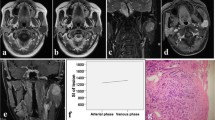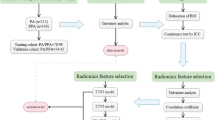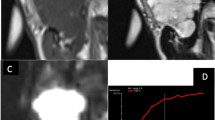Abstract
Objective
The purpose of the study was to assess diagnostic performance of MSCT images in patients with parotid benign tumors and provide useful criteria for the characterization of their various pathological types preoperatively.
Methods
Retrospectively analyzed clinical and imaging characteristics of 84 cases of pathologically confirmed primary parotid benign tumors. MSCT plain-scan and enhanced-scan were performed in all cases. After injection of 50 mL contrast material at a rate of 3.5 mL/s, spiral CT scans were obtained at arterial and venous phases with scanning delay of 30 s and 75 s, respectively. The attenuation change and enhancement patterns in the tumors were assessed. Quantitatively assess the increased CT number of the tumors in different enhanced-phases compared with the plain-scan and the ratio of increased CT number at venous phase scanning to that at arterial phase scanning also was calculated.
Results
In all of 84 cases, 40 cases were solitary pleomorphic adenomas, 29 cases were adenolyphomas, 6 cases were multiple tumors, 2 cases were bilateral, 15 cases were Basal cell tumor, and one of them had two small lesions. The diameter was 1–5 cm in most of cases, whose margin was smooth and clear, cystic changes in some cases. At two-phase scans, pleomorphic adenomas showed a pattern of slight enhancement and venous enhancement, adenolymphomas showed a pattern of strong enhancement at arterial phase scanning with a decrease at venous phase scanning, basal cell tumor showed a pattern of persistent strong enhancement with commonly significant cystic areas. The ratio of increased CT number was significant different between adenolymphomas and other pathological types.
Conclusion
The evaluation of enhancement patterns at two-phase enhanced-scan MSCT is helpful in the differential diagnosis of parotid gland benign tumors.
Similar content being viewed by others
References
Rabinov K, Kell T Jr, Gordon PH. CT of the salivary glands. Radiol Clin North Am, 1984, 22: 145–159.
Casselman JW, Mancuso AA. Major salivary gland masses: comparison of MR imaging and CT. Radiology, 1987, 165: 183–189.
Liu QS, Liang CH, Huang B, et al. The CT and MRI diagnosis of parotid adenolymphomas. Chin J Radiol (Chinese), 2005, 39: 406–409.
Choi DS, Na DG, Byun HS, et al. Salivary gland tumors: evaluation with two-phase helical CT. Radiology, 2000, 214: 231–236.
Gnepp DR, El-Mofty SK. Salivary gland. In: Damjanov I, Linder J, eds. Anderson’s pathology. 10th ed. St Louis, Mo: Mosby, 1996. 1616–1646.
Takashina S, Noguchi Y, Okumura T, et al. Dynamic MR imaging in the head and neck. Radiology, 1993, 189: 813–821.
Jang MJ, Park DW, Lee SR, et al. Basal cell adenoma in the parotid gland: CT and MR findings. AJNR, 2004, 25: 631–635.
Jeong AK, Lee HK, Kim SY, Cho KJ. Basal cell adenoma in the parapharyngeal space: MR findings. Clin Imaging, 2001, 25: 392–395.
Chiu NC, Wu HM, Chou YH, et al. Basal Cell Adenoma Versus Pleomorphic Adenoma of the Parotid Gland: CT Findings. AJR, 2007,189: W254–W261.
Author information
Authors and Affiliations
Corresponding author
Rights and permissions
About this article
Cite this article
Dong, Y., Wu, J. & Ge, Y. The value of MSCT in diagnosis of parotid benign tumor (An analysis of 84 cases). Chin. -Ger. J. Clin. Oncol. 9, 349–353 (2010). https://doi.org/10.1007/s10330-010-0610-9
Received:
Revised:
Accepted:
Published:
Issue Date:
DOI: https://doi.org/10.1007/s10330-010-0610-9




